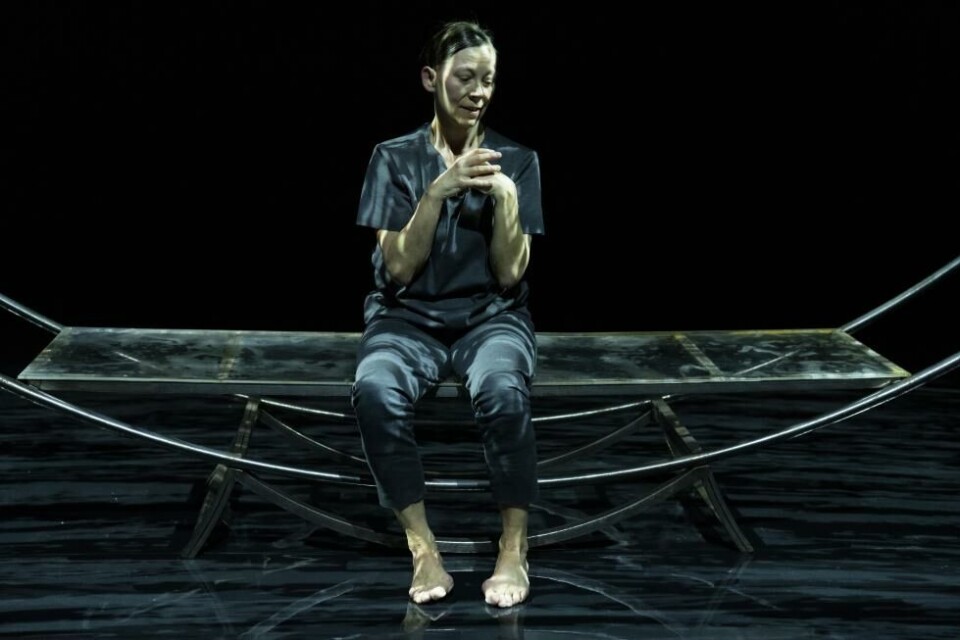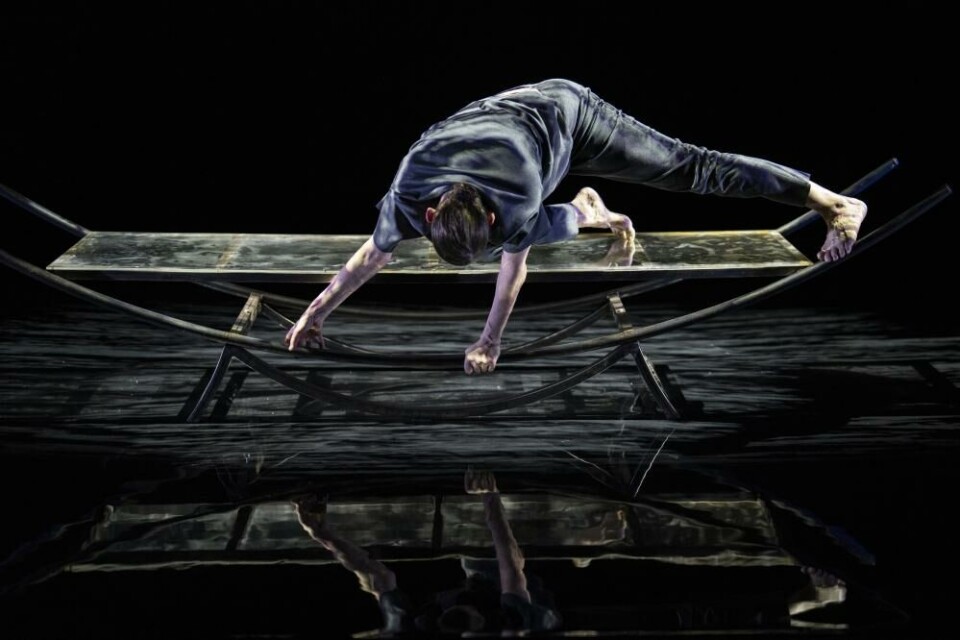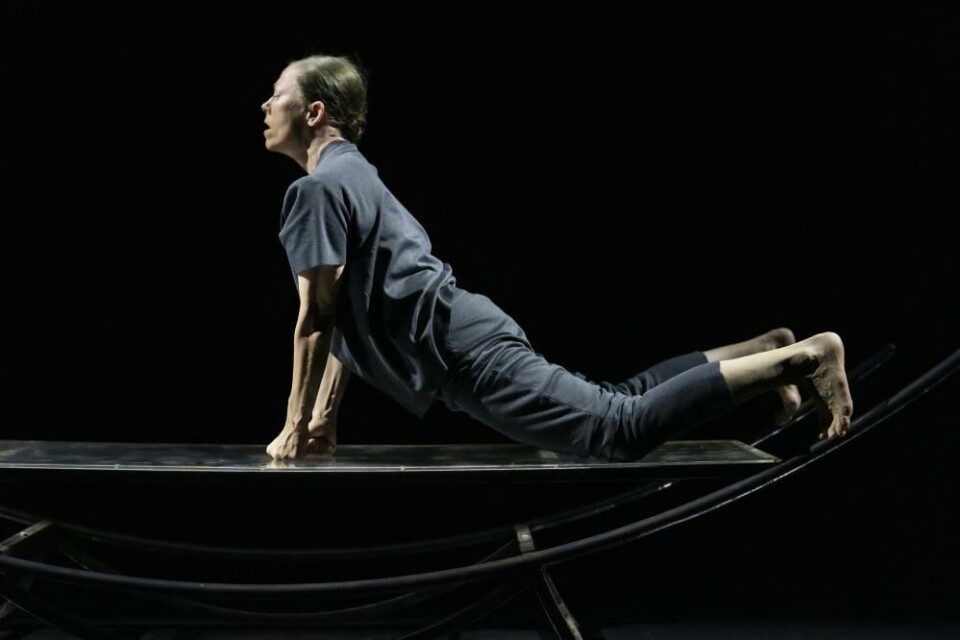
A Taste Of Time
UNDER, a performance by one of Norway's best-known choreographers, Sølvi Edvardsen addresses the topic of loneliness in a universal way, and raises in me unexpected questions of specificity, legacy and «other-timeness».
There is an image in my head. It’s a memory from when I still lived in Brussels. A Sunday, somewhere in the late morning. Passing through the square, I
saw a man in his 70s sitting on a plastic chair at a plastic table outside of a frituur. He sat there, all by himself, hunched over a pile of fries, a splash of ketchup and mayonnaise on it. He reminded me of my father: bad posture, a body denied for decades. It was early, too early for greasy food, it seemed to me. But the frituur had just opened. Probably the first client of the day, I thought. There was something about the image that made my stomach turn: the combination of the weathered man, the deep wrinkles in his face, the body giving into the weight of time, the plastic material barely holding the lonely situation together.
Rectangle
An image of loneliness can be sickening but also strangely poetic. UNDER, a new piece by the choreographer Sølvi Edvardsen, deals with the poetry of loneliness and appears to want to dig into the surface of humanity: going ‘under’, so to speak. As we enter the theatre, we see a dancer, Cecilie Lindeman Steen, sitting on what looks like a boat-shaped sculpture. Her eyes are closed, her hands folded in her lap as if she is contemplating or meditating. The performance eventually begins and a video is projected on the back wall of the stage. It is autumn. The forest is covered in stereotypically warm yellow, orangey red leaves. A season is not a meteorological phenomena but a feeling. This is something I read last week in Om utregning av romfang II by the Danish writer Solvej Balle, the second book in a series of seven that won the 2022 Nordisk råds litteraturpris. Watching Lindeman Steen on the screen wandering through this seasonal landscape, dressed in a heavy black coat, I can’t help but think about Balles protagonist, a woman stuck in time, living the 18th November on repeat. I also think about how I have felt her loneliness myself, even physically, and how it confuses me that I cannot tell what age she is.

Meanwhile on the screen, Lindeman Steen finds a bench and sits down. A close up of her face, eyes closing. Then we cut from the image back to the stage. The sculpture Lindeman Steen is sitting on is no longer a sculpture, but an object referring to a bench in a parallel world. No wood or warm autumn colours here, only glass and steel: cold materials standing lonely in the darkly lit, almost sterile space. A shiny dance floor creates a rectangle under the rectangular sculpture, placed on the rectangular bühne. In this confined world-on-stage, we watch Lindeman Steen as she explores a multitude of relations with and around the bench-like sculpture. She starts off frontally, her face expressing empty sadness almost echoing a Pierrot-like figure. Dressed in dark grey t-shirt and pants, the cut and fabric of which makes me think of workers in private clinics, we see Lindeman Steens snow-lit arms and hands swirl through the air. The gestures remind me of sign language but also pantomime, and orchestra conductors. It’s as if Lindeman Steen is sculpting and conducting the space around her, while also expressing a certain failure of communication. From the left front corner of the stage, Bjørg Lewis plays the cello to a pre-recorded composition by Åsmund Feidje. This ensemble creates an enchanting atmosphere while driving the dramaturgy, introducing new chapters with new musical themes. Hearing in the music the high-pitch ghostly voices and looking at the reflection of the shiny surface on the ceiling and shadows of Lindeman Steen on the sidewalls, I suddenly think of the word ‘under’ and how, in Norwegian, it also means ‘wonder’.
Old School
It is quite rare today to see dance or choreography focusing on only one emotion or one state of mind. I can’t say exactly why, but somehow I think of it as an approach from another time: a time of universal feelings, a belief in a shared human condition, an insistence on a centre. This “other time-ness”, which I guess some would call modernist or just old-school, is something that reverberates not only in the mise-en-scene and the aesthetics of the choreography, but also the movement language. Even if UNDER contains a broad palette of physical expressions and poetic readings of the woman-on-the-bench theme, the silent virtuosity of the dance feels somewhat bizarre, as coming from another time. A time where one would not hear the dancer, not even one of her breaths.
I am aware that this might sound like classic generational criticism, but I am genuinely curious about why we experience art as timely or untimely, or ‘trendy’ or not, an anachronistic or not, and so on. In that sense, it is fascinating to see dance artists presenting work at a late stage in their career, and observe how they, by just being present, make their own dent in time.
Doors
In an interview with Dansinformasjonen* about UNDER, Sølvi Edvardsen explains how she has been interested in form both as content and as expression since the mid 80s. In UNDER, she says, she wanted to work with loneliness as a way to point towards the increasing presence of machines and screens in today’s society. She talks about alienation, isolation and how it affects both young and old, and that it was not always this way. Edvardsen knows this because she was a child in the 1950s, a time when both people and messages still “needed to walk through doors” to get a conversation started.
Her comment made me laugh: it’s funny and spot on. At the same time, this simple explanation feels almost too simple. Even if it makes sense to divide the world into young and old, simple and complicated, it seems to me also important to acknowledge that loneliness can be quite different depending on a variety of factors, such as age, background and where you live on this planet. The social isolation of a Norwegian-born retired person who recently lost their partner is not the same as that of an Oslo teenager whose family migrated from the Global South, which again is different from that of an incel spreading violent misogynistic comments online. These are all variations of loneliness, but the intersection of what makes them specific is more complex than ‘too many screens, too many machines’.
A certain loneliness

Still, UNDER does refer to a certain kind of loneliness and I wonder why the talk around the performance seems to want to avoid it, namely the relationship between loneliness and ageing. Seeing this performance made me want to talk about the fear of ageing alone. It made me want to talk about the nuclear families who began living separated from their ageing parents. It made me want to talk about living in countries where there is a wealthfare system that takes on the role of carer, giving many of us, especially women in the prime of their lives, the freedom to care less for others. It made me want to talk about the consequences of this system and how the elderly are housed with other elderly, even though studies say that separation is detrimental. It also made me want to talk about something a friend told me the other day; when you become a woman in your sixties, she said, ‘It’s like you disappear.’
Loneliness doesn’t have a gender or age or ethnicity or class, but these elements do affect the expression of that loneliness…. And here my train of thought stops. The argument slows down and as I write this, I feel suddenly hyper conscious of all the ways in which I might be shaped by my own time. Here I am, throwing analyses and identity politics on the work of a choreographer from a completely different generation. As if I somehow know better, as if I am somehow right. A movement teacher who is past 75 recently said, after having listened to me ranting about my life: ‘You (read: younger people) always make things so complicated. Why?’
Tip Tap Tip Tap
Sølvi Edvarden is said to be one of Norway’s best-known choreographers. She has built an impressive oeuvre since the mid 80s, starting as a dancer and choreographer with Collage and later pursuing her own work as a choreographer with Dansekompani, Nasjonalballetten, Carte Blanche, Oslo Danse Ensemble and Festspillene i Bergen. The same goes for Lindeman Steen, a dancer who has had a prominent role in the field of dance for decades, and who is currently the programmer at PRODA, an organisation that offers daily training to professional dancers. UNDER is in fact not the first collaboration between these two ‘grande dames’ of Norwegian dance. 25 years ago, Edvardsen choreographed another solo with Lindeman Steen called SORT VASE. Unfortunately, I have not been able to see a recording of it, all I found was a black and white picture online, showing a black vase from which Lindeman Steen’ flexible body appears as if it is a flower. Again, another time.
In UNDER, we can lean back in our theatre seats, tap into art-historical shifts and witness how an insisting commitment to one’s art creates, but also messes with, what we perceive as the taste of our own time. And all because Norway is one of the few places in this world where you can actually make a career in dance past midlife, a remarkable fact to say the least. And isn’t it nice to take a break, at least from time to time, from the emerging and the hyped? To be able and allowed to tap into a time where making dance art was not about writing the perfect application, coming up with shiny ideas that are interestingly complex but also sexy and sellable, where you didn’t face competition on all fronts, including from yourself, and where a shared fight for your art (dance!) came with optimism and hope. Instead of thinking of today´s acceleration and oversaturation, I would rather think of Lindeman Steen’s feet. There is one moment where they go tip tap, tip tap — and it’s so playful, so sharp. I see her feet dancing on the shiny black mat, and I am drawn into the traces of decades of her dance. Her feet weathered in form but nevertheless full of joy and a feeling of being alive. A pair of feet I might one day wish for, further down the line.
(Publised January 29th, 2024)
